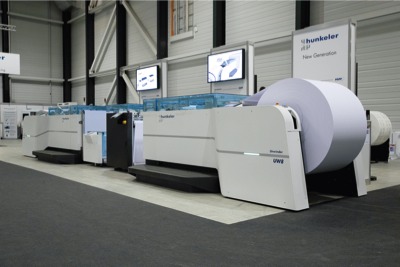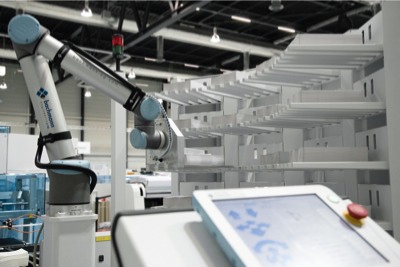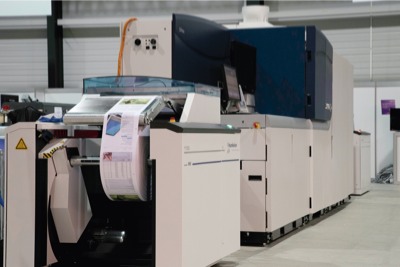Held every two years, the Hunkeler Innovationdays event is enjoying a burgeoning reputation for showcasing high speed digital printing technology. Andy Knaggs had a day to walk the hall.
For those engaged in high speed digital printing, the Hunkeler Innovationdays event, held every two years in Lucerne, Switzerland, has become an important staging post on the technology development highway. In 2013, this has been true again. While there were no major new inkjet web printing presses unveiled – rather, improved versions or variations on existing technology – there was something arguably more important, and that from the host company itself. It had promised the next generation of its Printer Online Paper Processing (or POPP) technology, and it duly delivered. POPP8, comprising the UW8 unwinding module and RW8 rewinding module was shown as a technology demonstration. ‘Customers want to run faster, and this is the answer – speeds of more than 300 metres per minute,’ said Philipp Fritschi, Hunkeler’s head of marketing communications. ‘It is very powerful and more automated. Users can change the reel in two and half minutes, whereas on version 7 that was about eight minutes.’ To be exact, the rated fastest speed of POPP8 is 305 metres per minute. It has a web width of up to 30 inches (762 mm).Further improvements from POPP7 to POPP8 include the capability to handle heavier paper reels, weighing as much as 1500 kilogrammes, and also heavier paper grammages, now up to 350 gsm. Mr Fritschi commented that this could see the technology used in the packaging market, as well as the more traditional publishing, direct mail and transactional markets. POPP8 also has a symmetrical design, so that the modules can be run in-line with digital print engines on either the left or right side.
 The POPP8 unwinding/rewinding technology
The POPP8 unwinding/rewinding technology
The context here is clear: if paper handling and finishing capabilities have been the cause of bottlenecks in these high octane print markets in the past, POPP8 suggests that a new generation of even faster web-fed inkjet engines that can be developed in the knowledge that paper processing capabilities further down the line are striding onward. It is a promise for the future though. Philipp Fritschi said the POPP8 technology would be commercially available at the start of 2014. Kodak’s Will Mansfield described the POPP8 technology as ‘very important’. He went on: ‘The limitation for inkjet up until now has been the speed at which the finishing goes, and many companies are running near-line because of that. As Hunkeler brings in faster finishing lines, that will help running costs too because printers can take time out of the process. The new high speed rewinder/unwinder will be perfect for our next generation Prosper press, as we go faster.’ POPP8 was not Hunkeler’s only innovation at its home event however. I tshowed a new robotic system (manufactured by Bachmann Engineering) on its 5000 books per hour book line, taking book blocks from the end of the line and placing them on a high capacity stacker. The book line itself has actually just been purchased by Ashford Colour Press, no doubt to use with the HP T230 inkjet web press that it has just invested in to produce colour and mono books. There was also the HL6 laser punching module, which was shown at drupa as a demonstration unit. This operates without any physical dies or perforation equipment, but instead uses lasers to dynamically punch a range of simple and complex security features and customised perforation patterns. It does so at impressive speeds of 150 metres per minute in 1-up and 2-up modes, and can be integrated into any Hunkeler configuration.
Around the hall
Elsewhere, there were announcements from Kodak and Xerox on the first day of the event: Kodak that it had launched a new Prosper press, the 5000XLi, with new press monitoring technology called the Intelligent Print System (IPS), which uses in-line video monitoring and advanced software controls to enable real-time adjustments that refine and optimise colour quality; Xerox with a new single engine configuration of its CiPress waterless inkjet web press, which was running a narrow web at the show. Further information about both of these systems can be found on page 8 of this issue. The Prosper 5000XLi has four major enhancements: the IPS; a new ink set that increases the range of substrates printable; an extended paper path for faster printing on a wider range of stocks; and a text enhancement feature. ‘Book printers really like IPS because it learns the patterns within the book and adjusts each page. It improves registration front and back,’ said Will Mansfield. That this was a problem on previous Prosper presses he denied, conceding that it had required ‘more operator intervention’. He also revealed that the next generation Prosper – called the Prosper 6000 at drupa, where it was a technology preview – will be on the maket next year. While Xerox made a formal announcement regarding its single engine duplex CiPress waterless inkjet web, there was another new press on its booth. This is a variant of its iGen technology. The press is called the Color 8250, and its place is seen as filling a gap for those companies printing with mono and highlight colour cut sheet systems who are experiencing growing demand for colour direct mail and transactional work, but without the volume yet to contemplate an inkjet web press investment. To fall into line with the transactional market, where ink coverage is generally low, it will be sold on a ‘toner out’ model, where users pay a maintenance fee and then consumables costs, rather than a click charge. Xerox’s Kevin O’Donnell explained further: ‘The other market for it is providing a back-up or short run opportunity for bigger lines. You might be doing a run of a million statements, and 5% might be different or special, so you can print them on the 8250 without having to interrupt the big inkjet line.’ He also said that Xerox’s representation of Impika inkjet presses would soon begin to take off in the UK, allowing it to be ‘more consultative’ in respect of the advantages or disadvantages of waterbased or waterless inkjet. Horizon’s finishing technology was prominent at the show and was responsible for finishing much of the printed output being produced. A visit to its booth revealed a new PUR binder, the single clamp BQ-280, which has been built specifically for PUR, as opposed to being modified for the process. The 500 cycles per hour machine uses new techniques for spine preparation and glue application, giving a better quality bind. Also new were the HT-1000V variable trimmer and the HOF-400 high speed feeder, while the drupa-previewed CRF-362 creaser/folder is now launched. Italian manufacturer Meccanotecnica was showing its Universe thread sewing technology for the first time, sold in the UK by Kolbus. The manufacturer said this technology produces a stronger bind than perfect binding and has better layflat properties. Halstan Printing Group in Amersham has just installed the UK’s first such system.
 An inline robot has been added to Hunkeler’s book line
An inline robot has been added to Hunkeler’s book line
Mono matters
While colour inkjet presses such as the Kodak Prosper, HP’s T-Series Inkjet Webs, Screen’s Truepress Jet520, KBA’s RotaJet 76, the Xeikon 8000, and the Océ ColorStream 3900, usually hog the headlines, there are still interesting things happening in the mono high speed digital printing world, as evidenced by the presence at Hunkeler of Graph-Tech, showing its MonoCube – a technology that emanates from the old French manufacturer Nipson. Bryan Palphreyman, the firm’s commercial director, said that many print companies with colour inkjet presses were still putting a great deal of black and white jobs through the presses – in one case, he said, colour was only 17% of the work going through. ‘The manufacturers have rushed to colour and the whole market has a bit of hole in it,’ he said. ‘Colour is coming, and we have a colour plan going forward, but there is still a big legacy of mono work. We have a cost effective device that is disruptive enough to make people think again.’ This ‘disruptive’ model is another one that dispenses with the click charge, and the maintenance fee too in this instance. The engine has been engineered so that very little maintenance is needed, and what little is needed can be done by the user. ‘We say, you buy the machine and the ink, and we will provide spares and train your operators. There is no per thousand feet charge or maintenance fee per month. We think this is very attractive to the market. It’s clean and simple, and people know where they are. Looking at the cost per page analysis, it’s also very cost effective against toner and other inkjet presses,’ said Mr Palphreyman.
 The latest Xerox CiPress on show
The latest Xerox CiPress on show
Branching out
This Hunkeler event was the first since Ricoh completed its integration of the old IBM Infoprint business – another noted mono high speed digital player, predominantly in transactional in the past. There are colour systems on the books too now (the InfoPrint 5000GP), and the company is intending to broaden its continuous inkjet penetration beyond transactional into books, direct mail and more commercial applications. Other highlights of its stand were new high capacity infra-red dryers for the Infoprint systems, being shown in Europe for the first time, and Cadence – a workflow software product for tracking all components of a book for very short run book production – which was shown as a technology demonstration. Canon is another company that has changed fundamentally since the previous Hunkeler Innovationdays in 2011, and its booth display of the Océ ColorStream 3900 inkjet press was ample demonstration, incorporating dynamic perforating and punching, as well as plow folding and cutting, to produce 3-up book blocks on a second line. Peter Wolff, head of Canon’s commercial printing group in the EMEA regions, told Digital Printer, ‘we believe in inkjet and liquid toner for the future’, thereby giving voice to a little mentioned technology announcement that was made at drupa: InfiniStream – a liquid toner technology from Océ that is still in development. A B2 press was shown to journalists and analysts at Canon/Océ’s facility near Munich last May. Mr Wolff continued: ‘The first products will be in about two years’ time and will be dedicated to the packaging industry. It will be on a productivity level of sheetfed litho at 7200 B1 sheets per hour.’ Significantly closer to launch is a new Jetstream continuous feed full colour inkjet press, running at 254 metres per minute with a 30 inch web, which Canon/Océ willlaunch in March 2013. Screen’s message was more about software than hardware, although it has developed a new denser black ink for its mono Truepress Jet. ‘People forget about workflow, when really if you get that right, these presses become green button machines,’ said Screen’s Tim Taylor. He also nodded towards the importance of ongoing development with paper types for high speed inkjet printing, which have been playing catch up for some time. He said: ‘The market is getting big enough for the major paper companies to get interested and we see that developing more. We want to see more inkjet-friendly papers, and inkjet friendly glossy paper is the real goal for a lot of the paper companies.’
Good impressions
Without exception, the exhibitors at Hunkeler spoke in glowing terms about the quality of visitor that was coming to their booths. They were the decision makers and the real production experts with a zeroed-in focus on high speed digital printing across transactional, direct mail and publishing sectors. The value to visitors of a show where every technology supplier that counts is within a single hall is therefore obvious. During a period when the equipment manufacturers seem to be increasingly reassessing the value of major exhibitions, this one seems to hit the spot for them too. Kodak’s Will Mansfield enthused: ‘We really love this show. Everyone here is a decision maker. When I walk around I’m seeing more solutions intended to take labour out of the process, and more automation at the back end. Finishing is closing the gap with the engines in speed, and automation is taking labour out of the last bastion of hand working in binding. And there is inkjet, inkjet everywhere.’ Ricoh Europe’s business development director Graham Moore gave his impressions of the event overall, as he said: ‘It’s clear from the proposition of the show that end to end solutions and finishing are ever more important, and we will continue to work with Hunkeler as we move forward. There may well be times when our customers need to print a very considerable volume and finish it in a short period of time. I think POPP8 proves that finishing solutions are moving towards not being a limiting factor.’





